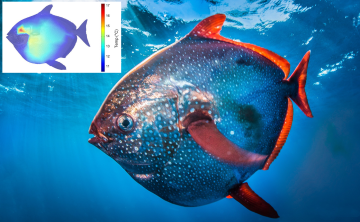combined4_360 px width.png

The opah is the only known fully warm-blooded fish (see inset for thermal map), which is a great advantage for living in deep, chilly ocean waters. Opah credit: Ralph Pace, NOAA Fisheries; Heat map credit: Nick Wegner, NOAA Fisheries.
You might remember learning that mammals and birds are warm-blooded, meaning their bodies can generate heat to maintain a fairly constant body temperature, while fish, reptiles and amphibians are cold-blooded, relying on heat from the environment since they cannot regulate their body temperature on their own. But then, you’ve probably also learned that there’s nearly always an exception to every rule. Deep under the sea, that exception in the fish world is the opah.
Also commonly called moonfish, opahs are typically about the size of a manhole, though one species can reach up to six and a half feet. They’re a bright silvery fish with a reddish-orange tint that grows darker toward the posterior, and they’re covered in white spots with reddish-orange fins. But what’s most distinctive about this fish is its ability to maintain its body temperature about 5° C (9° F) above the surrounding water temperature. Some fish can temporarily warm their swimming muscles or certain parts of their body, an ability called regional endothermy. But the opah is fully endothermic—basically a warm-blooded fish, using its swimming muscles rapidly enough to heat its entire body, including its heart and brain.
This ability comes from the unique design of its blood vessels. The veins that carry blood that was warmed by the muscles wrap around—and warm up—the arteries that carry cold blood that was cooled when it passed through the gills. For a fish living in chilly waters about 150 to 1,300 feet deep, this skill gives the opah a significant advantage. Just like mammals, fish become more sluggish in the cold, but the opah can swim faster, remain more alert, see better, and react more quickly than other cold-blooded fish because of its ability to stay warm.


